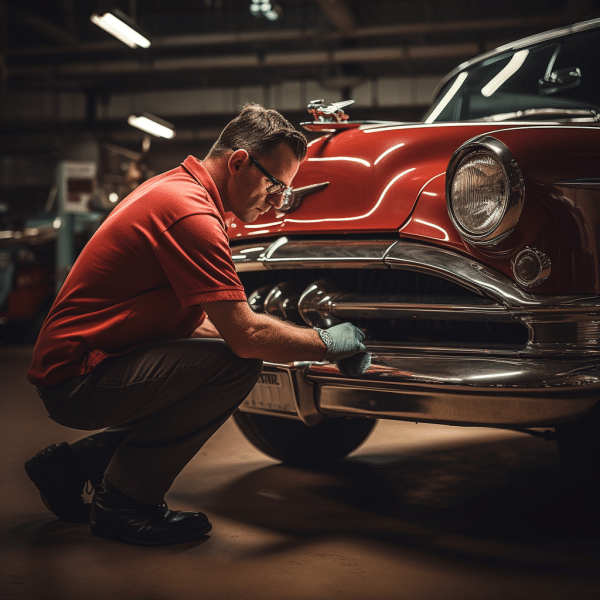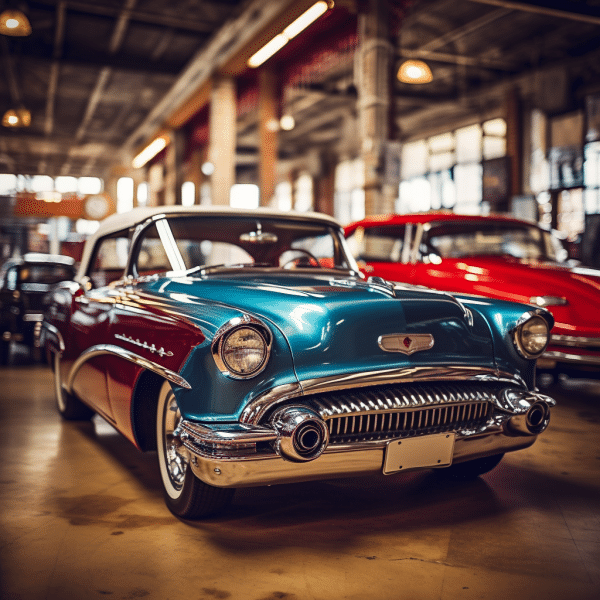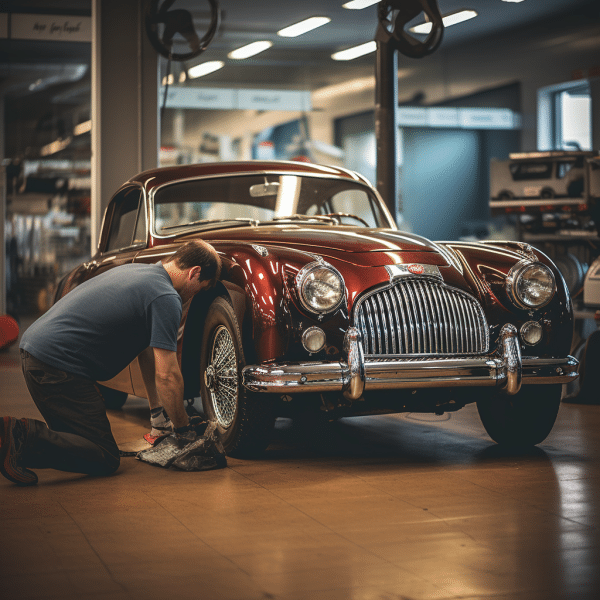
Mastering Classic Car Inspection: Tips for Buying Wisely

When searching for a classic car, it’s essential to inspect it before buying. Here are some Car Inspection Tips:
- Examine the exterior for rust, damage, or misaligned panels.
- Check the paint job.
- Move on to the interior; check each seat and all buttons and switches.
- Investigate the dashboard and gauges.
- Lastly, check the engine for leaks or dirt.
Mark had long wanted a 1969 Chevrolet Camaro. One day he found an ad, and rushed to the seller’s garage. Mark examined every inch of the car. It was in great shape, with only minor wear. The V8 engine purred. On a test drive, it was perfect. But what finally sold Mark was its past – it had been driven by a famous racecar driver. This gave it added history and prestige. Mark was determined to make it his own.
Importance of inspecting a classic car before buying
Inspecting a classic car is key if you want to invest wisely. Examining the vehicle helps decide its condition, authenticity, body, engine, and interior.
Look at the exterior for signs of rust or corrosion. Check the paint job for inconsistencies or shoddy repairs. See if the body panels are damaged or have been fixed before.
Move to the engine bay and look for oil leaks, belts and hoses that are worn-out, and any strange noises when starting the engine. Inspect the radiator for coolant leakage and check all fluid levels. Make sure the engine compartment is clean, which reflects how well the car has been taken care of.
Focus on the interior. Check the seats, carpets, and upholstery for wear and tear or stains. Test the dashboard controls and switches to ensure they are working. See if all gauges are accurate and check if any warning lights turn on when you start the car.
Research specifics related to the classic car you want to buy. Jay Leno said, “Classic cars represent our past dreams”. Inspecting it safeguards your financial investment but also lets you experience history and those dreamy days of driving.
Researching the specific classic car model
A table can help simplify the process of researching a classic car. It shows essential info like model year, manufacturer, and engine specs. Plus rarity, production count, body type, historical importance, current market value, and maintenance costs.
Examining these factors helps you understand its significance, scarcity, and worth. Knowing the maintenance costs of the unique engine can help you evaluate your investment.
But delve further into unique details about the model. Find out if any famous people owned it or any interesting stories. These extra findings can make owning the car more rewarding.
Don’t hesitate or miss your chance to own a piece of history. Act now while it still exists!
Physical inspection checklist
Inspecting a classic car? Here’s a checklist to follow!
- Examine the exterior for rust, dents, and paint damage.
- Check the body panels and door frames.
- Inside, assess the condition of the seats, steering wheel, and dashboard.
- Test electrical components like lights, windows, and radio.
- Look at the engine’s oil level and quality.
- Test the transmission’s gear shifts.
- Evaluate the suspension’s bounce-back.
- Check the brakes’ effectiveness and wear.
- Take it for a test drive to check its acceleration, handling, and braking.
- And have a mechanic inspect it too!
Pro tip: Gather as much info on the car’s maintenance records before buying. That’ll help make an informed decision.
Test driving the classic car
Here is a glimpse of what to look out for:
- Exterior Inspection – Rust, dents, and paint quality.
- Interior Inspection – Seats, dashboard, and controls for wear and tear.
- Engine Examination – Start up, noises, and leaks.
- Transmission Assessment – Clutch and gearbox performance.
- Braking System Evaluation – Brake responsiveness and efficiency.
Also remember to look into suspension, electrical systems, and documents.
Seat belts weren’t always a must-have in cars. It was only after research showed their importance that they became mandatory. Now, they’ve become a major safety feature in all vehicles, protecting passengers on test drives or any journey.
Verifying documentation and history
Verifying the documentation and history of a classic car before buying is a must. This helps buyers make informed decisions. Here are some important aspects to consider:
- VIN Number: Check that the Vehicle Identification Number matches on the title, dashboard, and door. Look out for signs of refinishing or repair work.
- Service Records: Read service records to see if the car has been well-maintained. Check for routine maintenance, repairs, and restoration work.
- Previous Owners: Knowing previous owners helps understand how well the car has been cared for. Reach out to them to get info about any specific issues or history.
Also, check any documents like brochures, manuals or advertisements that may provide info about the car’s original specs or features.
My friend’s experience serves as an example of the importance of carefully inspecting car documents. He unearthed valuable info about past ownership and maintenance. Thanks to his research and authentic papers—he got his dream vintage car with confidence!
Consulting with a professional mechanic
Ask specific questions about the car’s maintenance and repair history. A mechanic can offer guidance on potential costs for repairs or replacements. Their expertise will help you make an informed decision on the car’s current condition and its long-term prospects.
Moreover, a mechanic can spot hidden problems like rust, leaks, or electrical issues. They’ll also pay attention to details like VIN numbers.
Take notes during the inspection. Document the findings and recommendations for later reference. This will help when comparing different cars or negotiating with sellers.
Pro Tip: Choose a mechanic who specializes in classic cars. Their experience with vintage models will ensure a more thorough assessment.
Negotiating the price based on inspection findings
Use the inspection report as evidence to negotiate a fair price. Highlight any major issues to get leverage for a lower price. Consider market value when negotiating. Be prepared to walk away if the seller won’t budge. Get quotes for repairs and use them as evidence.
In addition, check aspects like originality, rarity and authenticity. Here’s an example of how inspection findings can be used to negotiate. A passionate car collector found his dream vintage vehicle but noticed some issues. He leveraged this information and got a lower price! This shows the importance of using inspection findings.

Conclusion
Inspecting a classic car is key before buying. Take your time to evaluate its condition. Check for rust, the engine performance, and if the parts are real. Test drive it too, to assess its functioning. This can save you future headaches.
Pay attention to details not yet highlighted. Examine the interior upholstery and electronic components. Don’t forget to check the car’s documentation history. Knowing past maintenance and ownership can give you insight.
A friend once bought a vintage sports car without inspecting it. He was seduced by the design and didn’t notice rust and worn parts. After a few weeks of ownership, he had to invest a lot in repairs. This highlights how important an inspection is before buying a classic car.
Additional resources and tips for classic car buyers
For a successful classic car purchase, there are helpful resources and tips. Consider these valuable insights:
- Do research. Before buying, learn about the make and model. Look for forums, books, and opinions about the car’s history, production numbers, potential issues, and market value.
- Get professional inspections. For vintage vehicles, contact experts who specialize in classic cars. They can examine the car’s mechanical components, body condition, and original features. This can save money.
- Join car clubs. Join a classic car club to connect with enthusiasts who share their knowledge and experiences. Members have access to resources like restoration shops, parts suppliers, and sellers.
- Attend auctions. Classic car auctions are a great way to learn about market trends and prices. Plus, you network with other collectors.
- Consult insurance specialists. Insuring a classic car is different due to uniqueness and value appreciation. Get help from insurance specialists.
- Save documents. Maintenance records, ownership history, manuals, and build sheets add value when reselling or appraising. Keep these documents safe.
When buying classic cars, trust your instincts and ask experienced collectors for advice. Learn the resources to enter the market confidently and find the perfect car. Enjoy restoring, owning, and experiencing classic cars.
Frequently Asked Questions
FAQ: How to Inspect a Classic Car Before Buying It?
1. What should I look for when Car Inspection?
When classic Car Inspection, pay attention to its overall condition, including the body, engine, interior, and any potential signs of rust or damage. Look for any modifications or aftermarket parts that may have been added, as well as any documentation of the car’s history and maintenance records.
2. How can I identify hidden rust on a classic car?
Inspect the car thoroughly for any signs of rust, including under the wheel wells, inside the trunk, and beneath the carpet or floor mats. Look for bubbling or blistering paint, discolored metal, or flaking rust. Using a magnet can help determine if there are hidden areas filled with body filler, indicating potential rust repair.
3. Should I hire a professional Car Inspection ?
If you are unsure about your own Car Inspection abilities, it is highly recommended to hire a professional inspector. They have the expertise and knowledge to identify hidden issues or potential problems that an untrained eye may miss. This can provide you with peace of mind and help you make an informed decision.
4. Why is it important to check the vehicle’s documentation?
Reviewing the car’s documentation, such as the title, registration, and maintenance records, can provide valuable information about the vehicle’s history. This includes details about previous owners, accident records, mileage verification, and servicing history. It gives you insight into how well-maintained the classic car has been over the years.
5. What should I consider during a test drive of a classic car?
During a test drive, listen for any unusual sounds, examine how the car handles, and check if all the functions (lights, brakes, indicators) are working as they should. Pay attention to the engine’s performance, acceleration, and braking. It’s also important to test the car under different driving conditions to get a better understanding of its overall condition.
6. How can I determine the value of a classic car?
To determine the value of a classic Car Inspection, consider factors such as its make, model, year, condition, mileage, rarity, and any special features or modifications. Research similar models that have recently sold to get an idea of the market value. Consulting with classic car appraisers or experts can also help you estimate the car’s worth.
